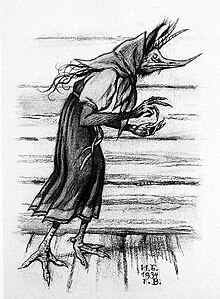Kikimora

Kikimora (Russian: кики́мора, IPA: [kʲɪˈkʲimərə]) is a legendary creature, a female house spirit in Slavic mythology, fin: Kikke Mörkö (sve: Mårran), sometimes said to be married to the Domovoi. She usually lives behind the stove or in the cellar of the house she haunts. The word "kikimora" allegedly derives from a phrase meaning "malicious spirit of Mara[vague]."[citation needed] The OED links "mora" with the "mare" of nightmare.[1]
There are two different kinds of Kikimoras. One kind lives in the forest; the other kind lives in the swamp. The Swamp Kikimora (Template:Lang-ru) is the wife of Leshy. Her presence can be recognized by wet footprints.
In some tales, she looks like an average woman with her hair down. (Married Slavic women typically kept their hair covered, and young unmarried girls kept it braided.) She may also be described as a small humpbacked woman in dirty clothes.[citation needed]
When home builders were unhappy with their clients, and wanted to do something harmful, they could introduce Kikimora into the new house, by making a doll in her fashion and placing it under the main beam or under the front corner of the house. Once Kikimora is in a house, it is difficult to get rid of her.
Kikimora is said to look after the chickens and the housework if the home is well-kept. If not, she will whistle, break dishes, and make noises at night. She also comes out at night to spin.[2] It is said that a person who sees Kikimora spinning will soon die. To appease an angry Kikimora, one should wash all the pots and pans with fern tea. An adder stone or a bunch of juniper twigs is hung above the nesting place of chickens to protect their eggs from Kikimora.
The legend is the basis of Kikimora (op. 63), a tone poem for orchestra by Anatoly Lyadov. Lyadov wrote that she "grows up with a magician in the mountains. From dawn to sunset the magician’s cat regales Kikimora with fantastic tales of ancient times and faraway places, as Kikimora rocks in a cradle made of crystal. It takes her seven years to reach maturity, by which time her head is no larger than a thimble and her body no wider than a strand of straw. Kikimora spins flax from dusk and to dawn, with evil intentions for the world."[3]
The Kikimora is mentioned by Russian "New Age" writer Vladimir Megre in The Space of Love, Book 3 of his "Ringing Cedars" series. Megre likens a man who marries unwisely based on looks and fashion to one who marries a Kikimora. A footnote in the English version describes the Kikimora as a malevolent female ghost said to attach itself to a particular house and disturb the inhabitants, males in particular. By extension, the term may also suggest an ugly woman in shabby clothing, ill-tempered and grumbling, striving to make life of her husband (and men in general) unbearable.[4]
A genus of the Linyphiidae family of spiders, discovered in 1988 by Kirill Eskov, was named by him Kikimora palustris.
References
- ^ "Mare". OED. Retrieved April 22, 2012.
- ^ "Polish Supernatural Spirits". Archived from the original on 2009-10-26.
- ^ Glass, Herbert. "Anatoly Liadov: Kikimora". Philpedia. Los Angeles Philharmonic Orchestra. Retrieved 28 December 2011.
- ^ Megré, Vladimir (2008). The Space of Love (The Ringing Cedars, Book 3). Kahului, Hawaii: Ringing Cedars Press. p. 156. ISBN 0-9801812-2-4. OCLC 224907446.
{{cite book}}: Unknown parameter|coauthor=ignored (|author=suggested) (help)
